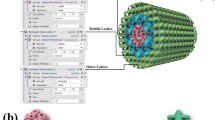Abstract
Residual stresses in composite constructions are created because of non-uniform contraction of layers during cooling from curing to ambient temperature. The aim of this study is to investigate the feasibility of incremental ring-core method to estimate non-uniform residual stresses in various laminates of polymer matrix composites. To carry out this test, glass/epoxy specimens were selected in two different types of symmetric cross-ply laminate \(\left( \left[ 0^{\circ }_{4}/90^{\circ }_{4}\right] _{S}\right) \) and symmetric quasi-isotropic laminate \(\left( \left[ 0^{\circ }_{2}/\pm 45^{\circ }/90^{\circ }_{2}\right] _{S}\right) \). The samples were created using hand layup and vacuum bagging. By experimental tests, released strains measured during milling process and coefficient factors for every annular groove machining operations were obtained by finite element modeling. As well, residual stresses were calculated by classical lamination plate theory. For symmetric cross-ply, the maximum difference between experimental and theoretical results was about 16%, which was observed in the first and eighth layers. Symmetric quasi-isotropic specimen showed also good agreement between the results and the maximum measurement error of 8% was observed. For the mentioned two cases, summation of components of the residual stress in all directions is near to zero. The results of this study show that in the ring-core method, because of the nature and higher volume of material removal than other methods, values of residual stress released are higher and the results have a good consistency compared with the theoretical values.









Similar content being viewed by others
References
Valentini, E., Benincasa, A., Bertelli, L.: An automatic system for measuring residual stresses by the ring-core method. Aias Ital. Stress Anal. Assoc. 229, 145 (2011)
Mathar, J.: Determination of initial stresses by measuring the deformation around drilled holes. Trans. ASME 56(4), 249–254 (1934)
Soete, W., Vancrombrugge, R.: An industrial method for the determination of residual stresses. In: Proceedings of SESA, vol. 8, no. 1, pp. 17–28 (1950)
Bert, C.W., Thompson, G.L.: A method for measuring planar residual stresses in rectangularly orthotropic materials. J. Compos. Mater. 2(2), 244–253 (1968)
Lake, B.R., Appl, F.J., Bert, C.W.: An investigation of the hole-drilling technique for measuring planar residual stress in rectangularly orthotropic materials. Exp. Mech. 10(6), 233–239 (1970)
Sicot, O., Gong, X.L., Cherouat, A., Lu, J.: Determination of residual stress in composite laminates using the incremental hole-drilling method. J. Compos. Mater. 37(9), 831–844 (2003)
Schajer, G.S., Yang, L.: Residual-stress measurement in orthotropic materials using the hole-drilling method. Exp. Mech. 34(4), 324–333 (1994)
Shokrieh, M.M., Kamali, S.M.: Theoretical and experimental studies on residual stresses in laminated polymer composites. J. Compos. Mater. 39(24), 2213–2225 (2005)
Shokrieh, M.M., Ghasemi, A.R.: Simulation of central hole drilling process for measurement of residual stresses in isotropic, orthotropic and laminated composite plates. J. Compos. Mater. 41(4), 435–452 (2007)
Civín, A.: Comprehensive Theoretical Analysis of Ring-Core Method for Residual Stress Determination, Faculty of Mechanical Engineering (2010)
Civín, A., Vlk, M.: Theoretical Analysis of Ring-Core Method for Residual Stress Determination. ANSYS, Canonsburg (2009)
Zuccarello, B.: Optimization of depth increment distribution in the ring-core method. J. Strain Anal. 31(4), 251–258 (1996)
Ajovalasit, A., Petrucci, G., Zuccarello, B.: Determination of Non-uniform Residual Stresses Using the Ring-Core Method, Department of Mechanics and Aeronautics, vol. 118 (1996)
Václavík, J., Weinberg, O., Bohdan, P., Jankovec, J., Holý, S.: Evaluation of residual stresses using ring core method. In: EPJ Web of Conferences, vol. 6, p. 44004 (2010)
Šarga, P., Menda, F.: Comparison of ring-core method and hole-drilling method used for determining residual stresses. Am. J. Mech. Eng. 1(7), 335–338 (2013)
Menda, F., Trebuňa, F., Šarga, P.: Determination of the necessary geometric parameters of the specimen in ring-core method. Mech. Mater. 486, 90–95 (2014)
Bouffioux, C., Pesci, R., Boman, R., Caillet, N., Ponthot, J., Habraken, A.M.: Comparison of residual stresses on long rolled profiles measured by X-ray diffraction, ring core and the sectioning methods and simulated by FE method. Thin Walled Struct. 104, 126–134 (2016)
Schajer, G.S.: Hole-drilling residual stress measurements at 75: origins, advances, opportunities. Exp. Mech. 50, 245–253 (2009)
Baldi, A.: Using Optical Interferometry to Restart the Ring-Core Method. Society for Experimental Mechanics, Bethel (2016)
ASTME837-99:1999: Determining Residual Stresses by the Hole-Drilling Strain-Gage Method. American Society for Testing and Materials, West Conshohocken (2002)
Ghasemi, A.R., Taheri-Behrooz, F., Shokrieh, M.M.: Measuring Residual Stresses in Composite Materials Using the Simulated Hole-Drilling Method, Residual Stresses in Composite Materials, pp. 76–120. Woodhead Publishing, Sawston (2014)
Ghasemi, A., Taheri-Behrooz, F., Shokrieh, M.: Determination of non-uniform residual stresses in laminated composites using integral hole drilling method: experimental evaluation. J. Compos. Mater. 48(4), 415–425 (2014)
Shokrieh, M.M., Akbari, S., Daneshvar, A.: A comparison between the slitting method and the classical lamination theory in determination of macro-residual stresses in laminated composites. Compos. Struct. 96, 708–715 (2013)
Tsai, S.W.: Composites Design, 4th edn. Think Composites, Dayton, OH (1988)
Acknowledgements
Thanks for the Cooperation of “Iranian gas transmission company- diat 2” in this article.
Author information
Authors and Affiliations
Corresponding author
Rights and permissions
About this article
Cite this article
Ghaedamini, R., Ghassemi, A. & Atrian, A. Ring-core method in determining the amount of non-uniform residual stress in laminated composites: experimental, finite element and theoretical evaluation. Arch Appl Mech 88, 755–767 (2018). https://doi.org/10.1007/s00419-017-1340-z
Received:
Accepted:
Published:
Issue Date:
DOI: https://doi.org/10.1007/s00419-017-1340-z




